Cork It Again Davis Google Maps
25 strangest sights on Google Earth
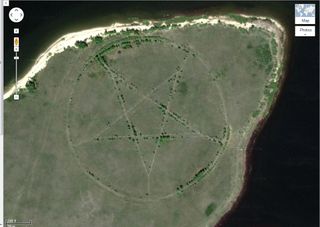
Google Earth compiles images from various sources, from satellites in geosynchronous orbit that snap low-resolution photos from tens of thousands of miles to a higher place Earth, to satellites closer to Earth that capture higher-resolution shots, and even aerial photos taken from airplanes, kites, drones and even balloons. The imagery is available to anyone who downloads the software, and archaeologists take taken reward of this rich resources.
From a boneyard of military planes, to a polka-dot design created by ants, to mysterious structures etched into the Gobi Desert and even a phantom island in the Due south Pacific, Google Globe brings some wacky places to lite. Here's a look at some of the strangest.
Sprawling swastika
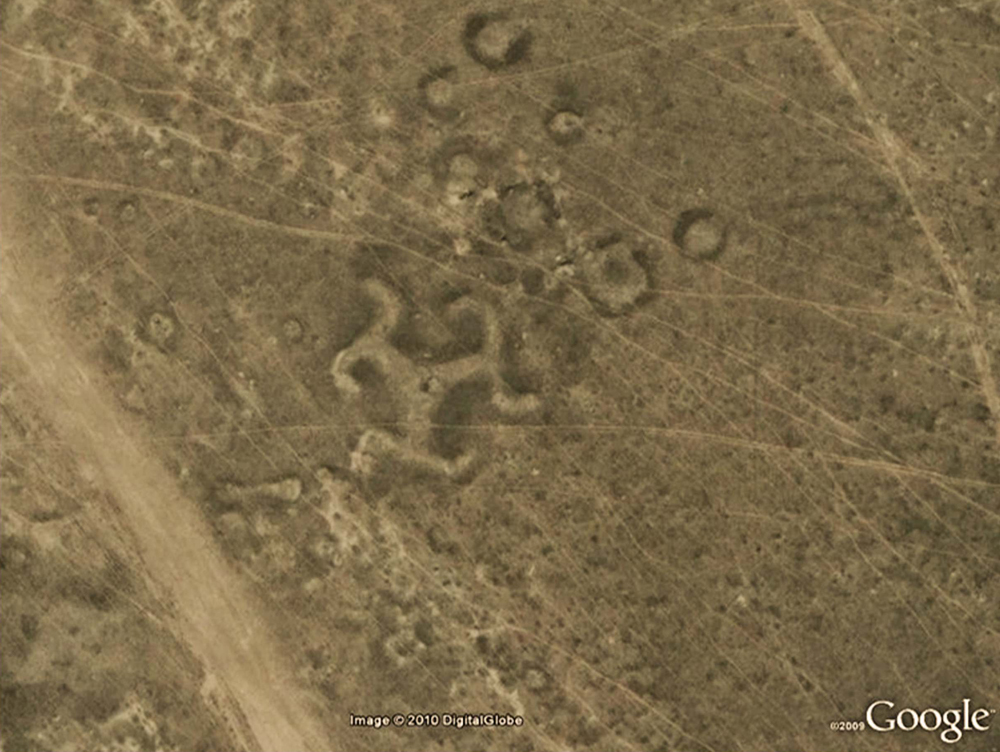
Scientists discovered more than l geoglyphs across northern Kazakhstan in Central Asia, including this swastika-shaped design. Though the swastika symbol was created from timber, many of the geoglyphs were made of earthen mounds. The geoglyphs seem to date back 2,000 years. At the time, swastikas were not uncommon across Europe and Asia and were not of course affiliated with any political behavior. [Read more about the swastika geoglyphs and other Kazakhstan designs]
The isle in a lake, on an island, in a lake, on an isle
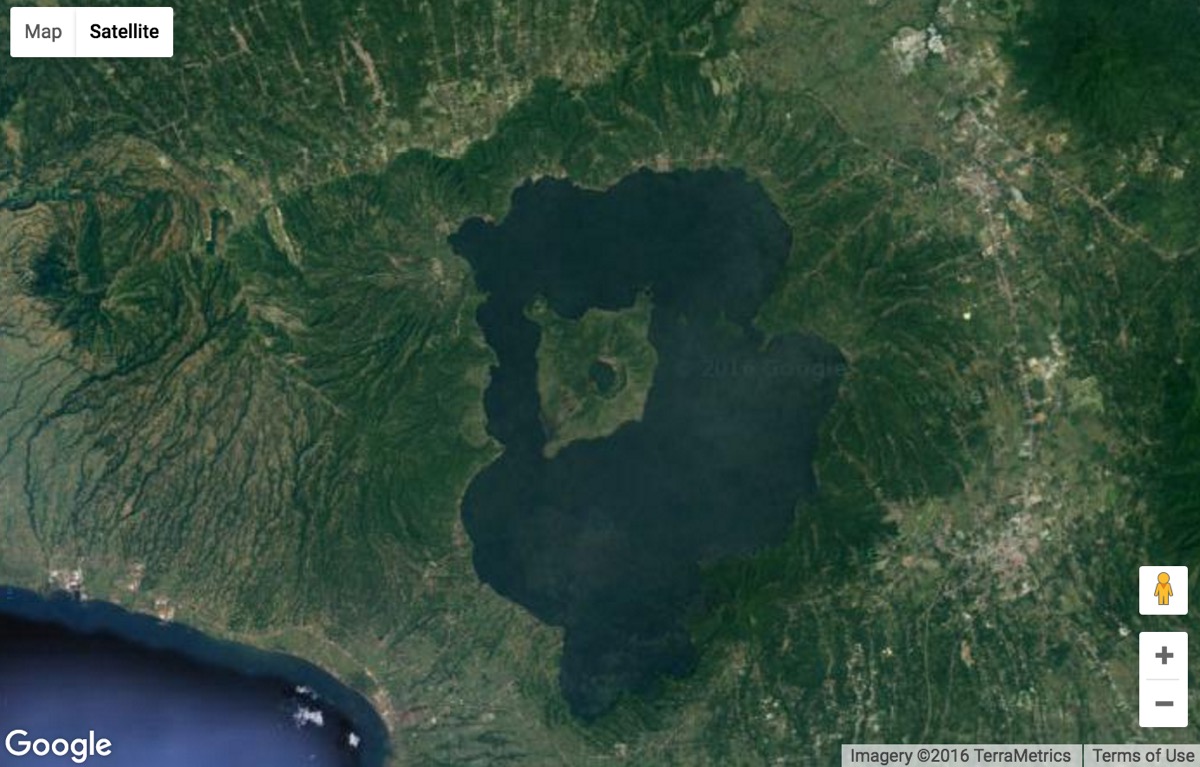
This Google Earth image is an eye-full and a mouthful, as it'south an island-in-a-lake-on-an-isle-in-a-lake-on-an-island. Yes, Google Globe captured this image showing a tiny island that resides inside a crater lake on an isle called Volcano Island in a lake called Taal lake on the Philippine island of Luzon. For years plain, this miracle was thought to exist the largest of its kind spied past Google Globe. Notwithstanding, information technology turns out that accolade goes to a 4-acre spit of land in northern Canada where no human being has likely stepped foot.
Weird Wheels
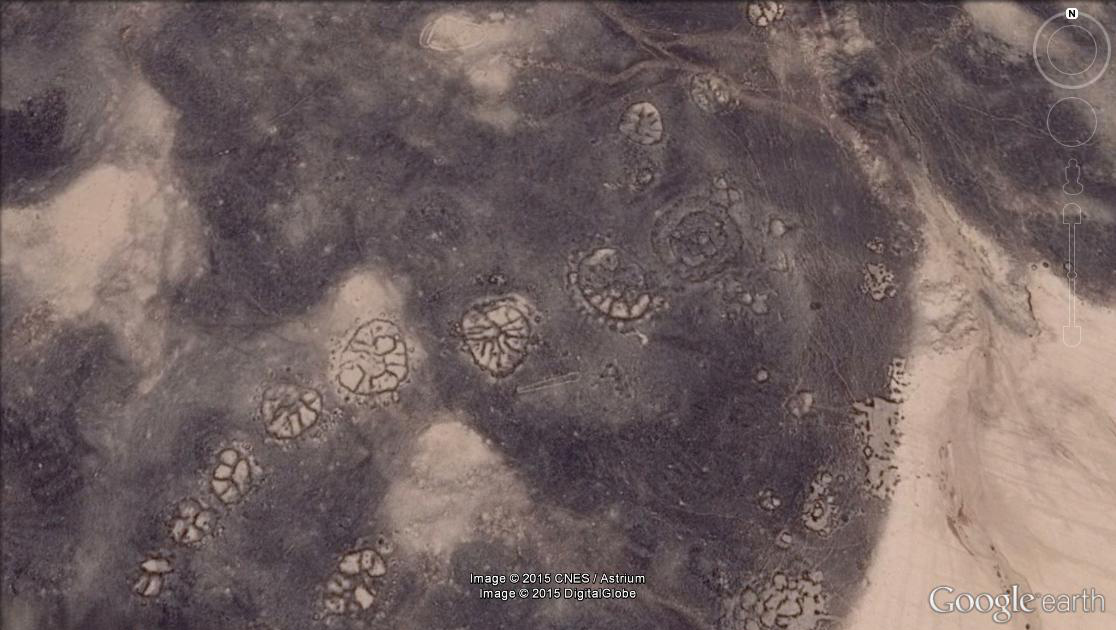
Google Earth has spied some old artistry etched into the surface of the planet, including bike-shaped geometric structures that may date back some 8,500 years, making them older than Republic of peru's geoglyphs called Nazca Lines. Some of these spoked designs that dot Hashemite kingdom of jordan's Azraq Oasis seem to exist positioned in a way that aligns with sunrise on the winter solstice. A team of scientists with the Aerial Photographic Archive for Archæology in the Middle East (APAAME) have been investigating wheel structures (besides called "works of the quondam men") with satellite imagery available through Google Earth.
The wheels vary in their design, with some showing spokes that radiate from the heart, others with but one or 2 confined rather than spokes and still others not circular at all and instead shaped like squares, rectangles or triangles, the researchers accept institute.
The wheels seen in this image are in the Azraq Haven and have spokes with a southeast-northwest orientation, mayhap aligning with the winter solstice sunrise.
Bull's eye
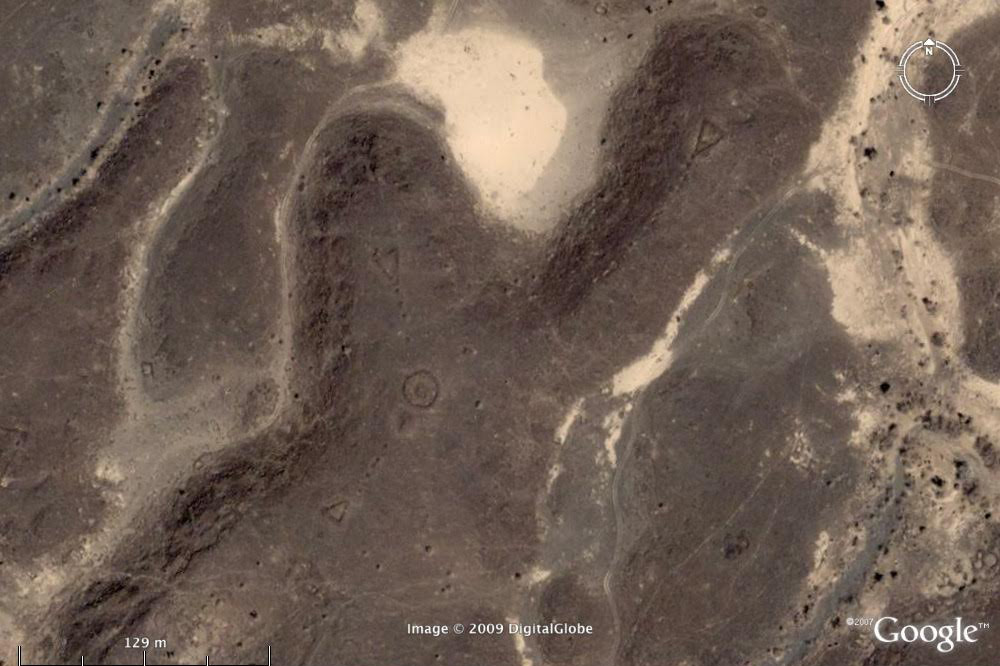
One type of these "wheels" in the Heart East looks like a bull's-eye, with iii triangles pointing toward the heart and small piles of stones leading from the triangles toward the balderdash's-centre bicycle. David Kennedy, of the University of Western Australia, who co-directs the project, calls it "a central balderdash's-eye tomb with, in this instance, three triangles each with at least a function of a connecting line of stone heaps running to the center."
Mysterious pyramid?
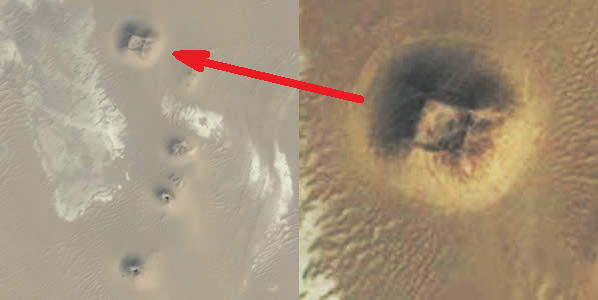
This image from Google Earth shows an bibelot that some believe could exist an unexcavated pyramid. Dozens of anomalies in Egypt take been detected using Google Earth in the past v years; even so, there is a debate as to whether they stand for natural features or artificial structures. More excavations are needed, only the security and economic state of affairs in Egypt has limited the number and size of excavations.
Egyptian pyramids?
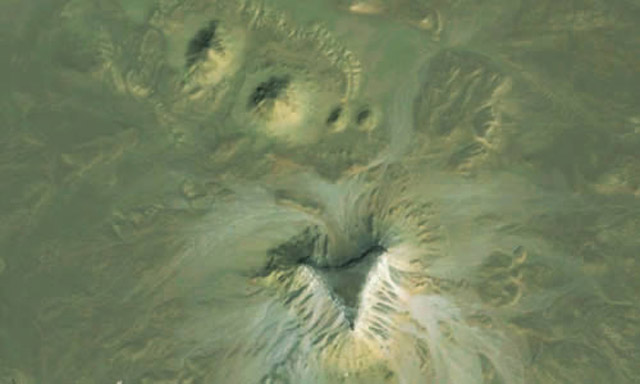
Eroded Egyptian pyramids or geologic features?
Phantom Island

In 2012, a group of Australian researchers "undiscovered" an island the size of Manhattan in the S Pacific. A mysterious place called Sandy Island had popped up on maps, northwest of New Caledonia. Information technology fifty-fifty showed upwards every bit a black polygon on Google Earth. But when scientists sailed in that location in Nov 2012, they found open h2o instead of solid footing.
In an obituary for the island published in April 2013, the researchers explained why the phantom landmass had been included on some maps for more than a century, pointing to some human errors and a possible pumice raft.
Puzzling Pentagram

On the current of air-diddled steppes of central Asia, in an isolated corner of Kazakhstan, there'southward a large pentagram, measuring roughly 1,200 anxiety (366 meters) in diameter, etched into Earth'southward surface. The v-pointed star surrounded past a circle, located on the southern shore of the Upper Tobol Reservoir, shows up vividly on Google Maps, the online version of the more than detailed Google Globe.
Many online comments linked the site with devil worship, nefarious religious sects or denizens of the underworld. Instead, the pentagram turns out to exist the outline of a park made in the course of a star; the star is marked by roadways that are at present lined with trees, making the star shape fifty-fifty more distinct in aerial photos.
Abandoned launch sites

Nike missiles, which were supersonic surface-to-air missiles, sat prepare to launch at about 300 sites across the United States during a catamenia of the Cold State of war, from 1954 to the 1970s. Some of those missiles even carried nuclear warheads. Those missiles became obsolete with the appearance of long-range intercontinental ballistic missiles (ICBMs).
David Tewksbury, a GIS (geographic information organisation) specialist at Hamilton College in New York, aimed to preserve a visual record of the abandoned Nike missile launch sites before they vanish — either as a result of being reclaimed by nature, repurposed by the military or redeveloped. His program is to build a geo-referenced database and then that anyone can research the Nike missile sites through Google Earth.
Hither, ane of those sites, the Oahu Defence force Area in Hawaii, is shown in 1968. The site was once equipped with missiles in the open air, with embankments betwixt paired launch sites.
Desert Breath

A spiral portal to an alternate universe? Maybe an conflicting message? Or an ancient monument to a supernatural being? This giant spiral blueprint in the desolate Egyptian desert, not far from the shores of the Red Sea, is an art installation chosen Desert Breath. In March 2007, Danae Stratou, Alexandra Stratou and Stella Constantinides created the 1 one thousand thousand foursquare pes (100,000 square meters) artwork meant to celebrate "the desert as a state of mind, a landscape of the listen," the artists say on their website.
Riddled with holes

The civil war in Syria has imperilled hundreds of archaeological sites, including causing damage to all six of the UNESCO World Heritage Sites in the country, which is considered 1 of the oldest occupied areas of the Earth. Satellites, in item, take shown much of this destruction, with some of the strangest imagery showing destruction in Apamea. There, Google Earth images have revealed the unabridged ancient Roman city has been pockmarked with holes dug past looters since the offset of the ceremonious war.
"It looks like the surface of the moon," Emma Cunliffe, an archaeology researcher at Durham University in England, who has published a report documenting archeological damage in Syrian arab republic, told Live Science in 2013. "In eight months, the looted area exceeded the total excavated area."
Lake of blood?

Outside Sadr Metropolis in Iraq, at coordinates 33.396157° Northward, 44.486926° E, lies a blood-red lake. At that place is, as however, no official explanation for the colour of this strange bounding main.
Ant-sy Art
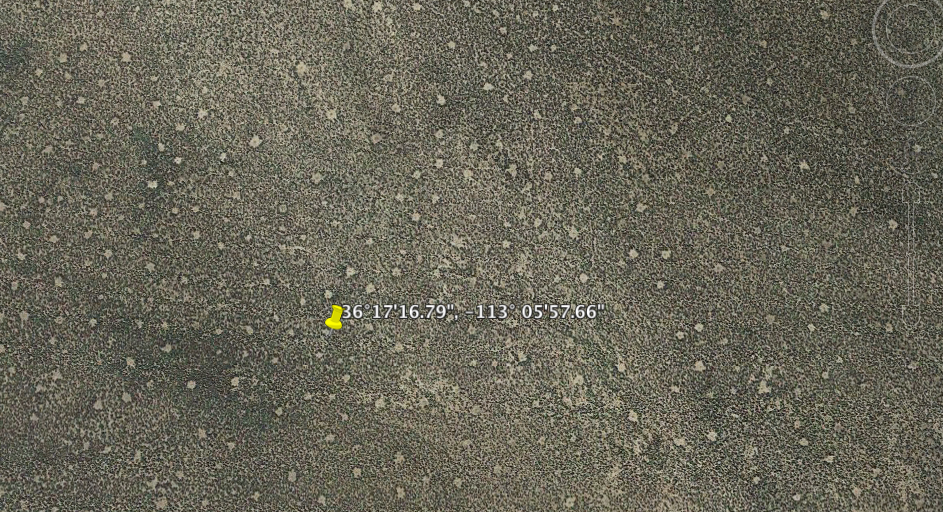
An odd polka-dot pattern near the cinder cone volcano dubbed Vulcan's Throne on the north rim of the Grand Coulee may have a elementary caption: ants. Turns out, the desert effectually the One thousand Coulee is dwelling to red harvester ants (Pogonomyrmex barbatus).
These pesky critters can create nesting mounds spanning some 47 inches (120 centimeters) beyond and are typically surrounded by bare basis upward to 108 square anxiety (ten square meters), co-ordinate to physicist Amelia Carolina Sparavigna, a specialist in prototype processing and satellite imagery analysis at the Politecnico of Torino in Ital. Sparavigna discusses her theory in a scientific paper posted online on January. xi, 2022 - the newspaper has yet to be peer-reviewed. The mounds may exist responsible for the aerial design of scattered circles, though Sparavigna says on-the-ground confirmation is needed.
Island in a lake
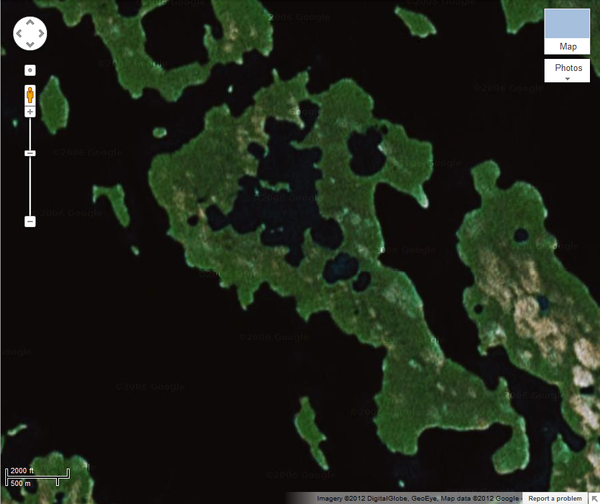
The globe'southward largest "island, in a lake, on an island, in a lake, on an island" is a narrow, four-acre strip of land in Canada located at exactly 69.793° Northward, 108.241° Westward. The nameless island (that little-tilde shaped squiggle of green) lolls across the eye of a small lake, which is itself encapsulated by a slightly larger island. That resides inside one of a series of long finger lakes located 75 miles inland from the southern coast of Victoria Island, a state feature in Northern Canada.
This lilliputian "sub-sub-sub island" would never have received its strange distinction if not for conscientious trolling of Google Earth by map geeks around the world. In all likelihood, no human has ever really set up foot in that location.
The boneyard
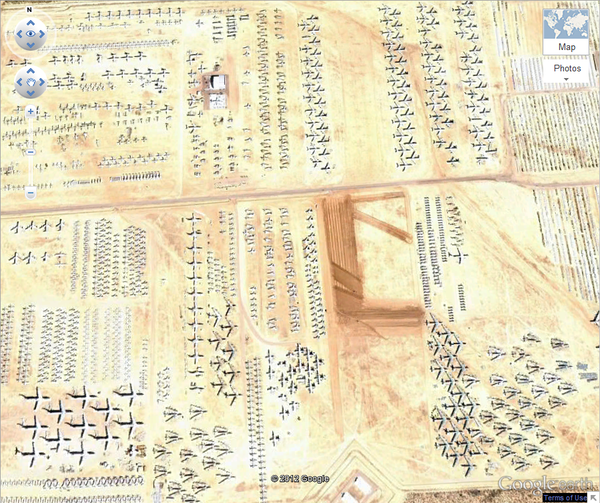
The Davis Monthan Air Force Base in Tucson, Ariz., is where U.South. armed services planes go to dice. Dubbed "the boneyard," this two,600-acre cemetery of steel at coordinates 32 08'59.96" Due north, 110 l'09.03"Westward is closed to the full general public, only Google World provides a high-resolution glimpse of what'south inside: virtually every aeroplane the armed services has flown since Earth State of war II — from the B-52 StratoFortress to the F-xiv Tomcat — in diverse stages of decay.
The boneyard at Davis Monthan was used as the backdrop in the music video for "Learning to Fly" by stone music legend Tom Niggling and the Heartbreakers. The band was shown performing among various shipping hulks.
Biggest word?
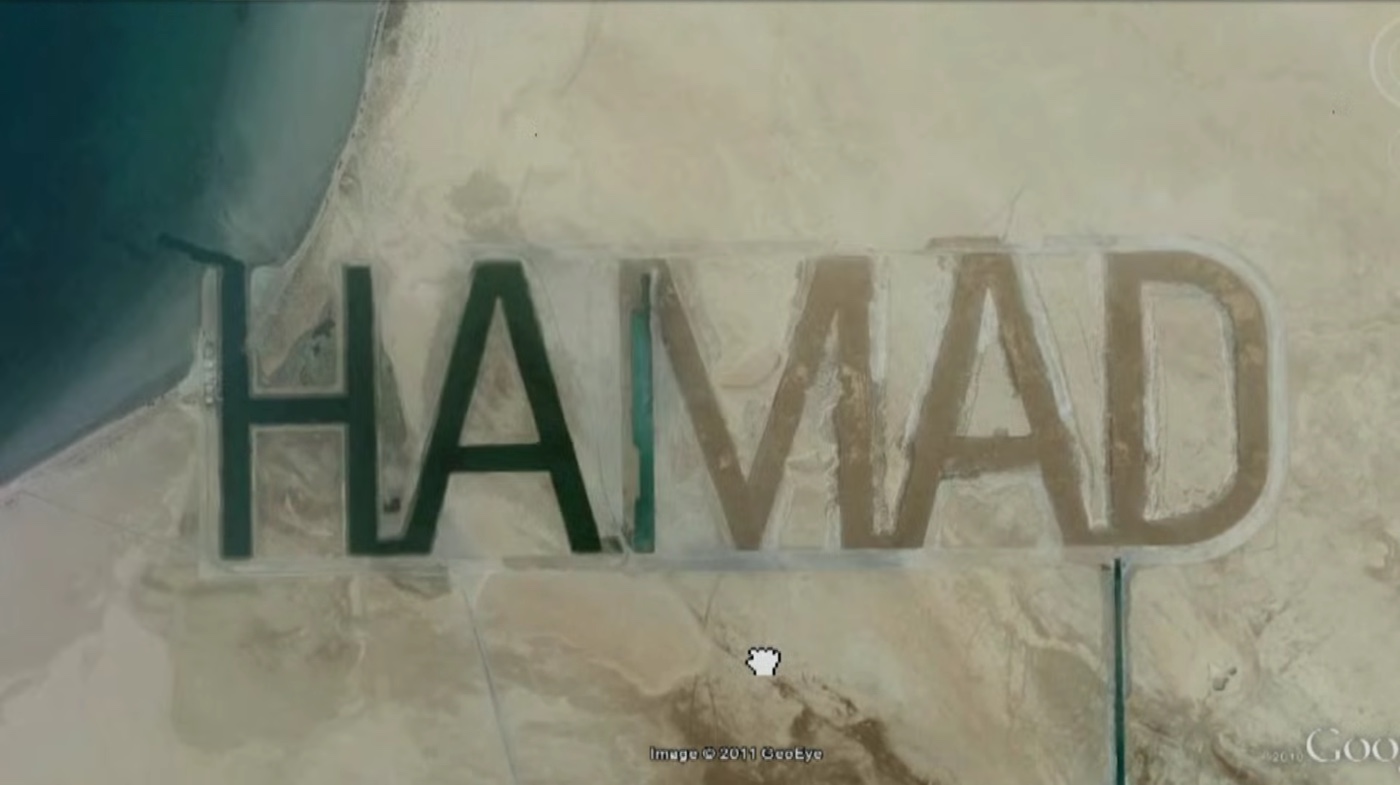
Hamad bin Hamdan al Nahyan, a billionaire Sheikh and fellow member of Abu Dhabi'due south ruling family unit, has had his proper name carved into the sandy surface of al Futaisi Island, an island he owns in the Persian Gulf. At half a mile tall and 2 miles long altogether, the letters HAMAD may be the globe'due south largest; regardless, they're visible from space.
Usually, words written in sand launder abroad, but these letters are large enough to form waterways that blot the encroaching tide. Indeed, at the time these satellite photographs were taken, said tide can be seen flowing through the letters all the mode to the M.
Wild view elephants
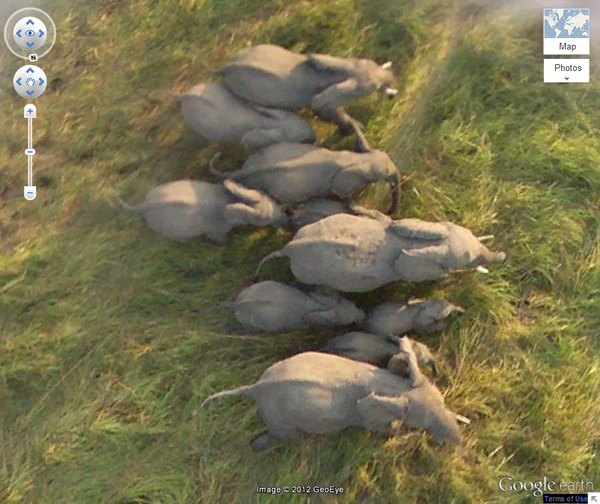
Thought you might never get to see a herd of African elephants in the wild? Luckily, satellites captured a few high-resolution images of a herd on the move in Chad, at coordinates 10.903497 N,xix.93229 E.
Conflicting bunker?
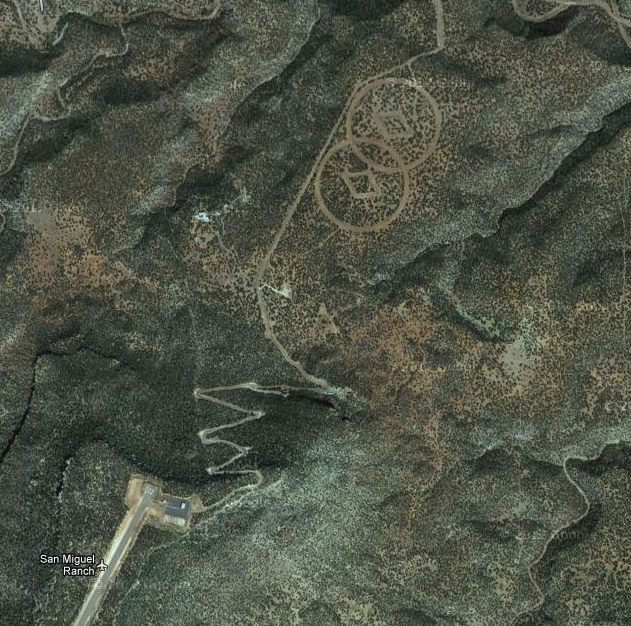
Found etched onto the desert floor near Mesa Huerfanita, New Mexico, are two large diamonds surrounded past a pair of overlapping circles. Author John Sweeney claimed that the site marks a hidden bunker belonging to the Church of Scientology.
According to their website, Scientology "is a religion that offers a precise path leading to a complete and certain understanding of 1's true spiritual nature and ane's human relationship to cocky, family unit, groups, Mankind, all life forms, the material universe, the spiritual universe and the Supreme Being," co-ordinate to the arrangement's website. Such symbols on the desert flooring are reportedly in that location to help guide these scientologists who return to Globe afterwards fleeing a planetary "Armageddon," writes the Daily Postal service. Of course, the symbols will likely remain a mystery.
Gobi Desert
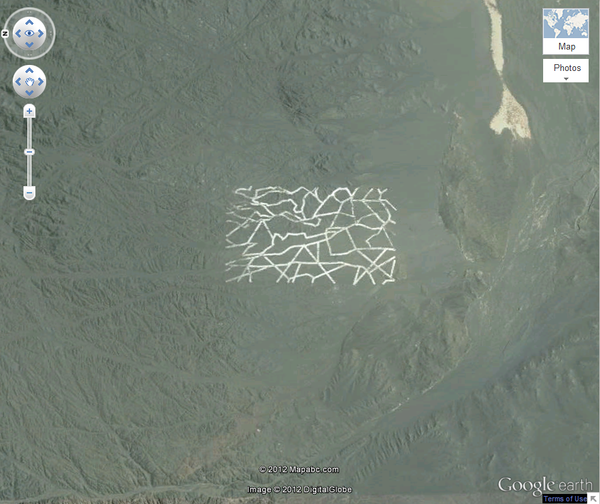
Newfound Google Earth images take revealed an assortment of mysterious structures and patterns etched into the surface of Communist china'due south Gobi Desert. According to experts, this is a secret armed services base of operations, and the structures are used for a variety of purposes including weapons testing, spy satellite scale and testing of radar instrumentation.
The most elaborate feature, an intricate grid of perfectly direct lines that weave back and forth every few hundred feet for 20 miles (33 kilometers), is nearly likely a Yagi antenna assortment, a device used for weather tracking and other atmospheric enquiry.
Mapvertising KFC
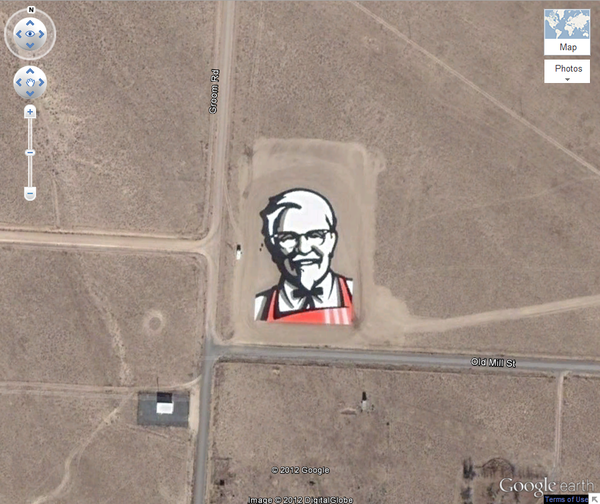
Considering the number of people who troll Google Earth in their free fourth dimension, it isn't surprising that enormous advertisements take started popping upwardly in remote areas for their viewing pleasance—a concept known as "mapvertising." The world'southward largest Coca-Cola logo, for example, can be seen at 18.5292 South, 70.2500 West on a hillside in Republic of chile; it is said to be made of 70,000 empty Coca Cola bottles. A 87,500-foursquare-foot pic of Colonel Sanders — the KFC logo— in one case appeared at 37.646163° N, 115.750819° W merely off Extraterrestrial Highway in Nevada, just has since been removed.
Sizable shipwreck
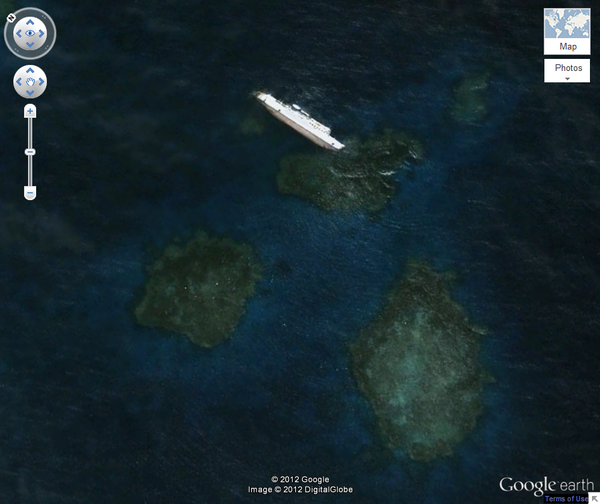
The S.South. Jassim, a Bolivian cargo ferry, ran aground and sank on the Wingate Reef off the coast of Sudan in 2003. At 265 feet (81 meters) long, it was one time one of the largest shipwrecks visible on Google Globe, located at 19 38'45.99"N 37 17'42.17E, although it now appears to have sunk nearly completely.
Landlocked lips
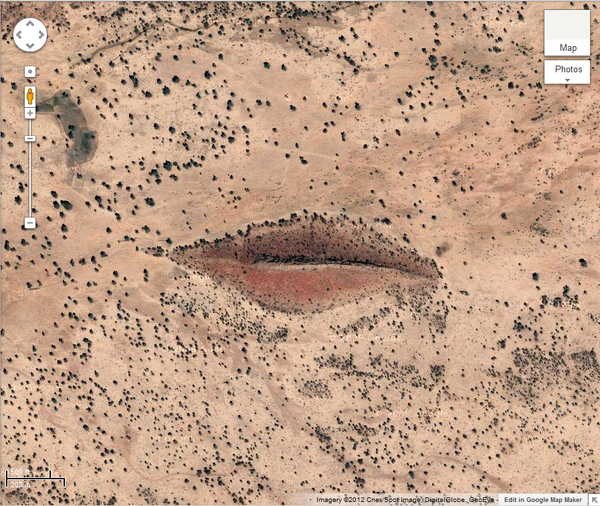
These luscious lips are a colina formation located in Gharb, Darfur, in Sudan at coordinates 12°22'thirteen.32"N, 23°19'20.eighteen"Eastward.
Aussie UFO?

In Australia, at coordinates 30°thirty'38.44"S 115°22'56.03"E, a strange triangle dotted with bright lights appeared in the centre of a field. When offset discovered in 2007, ufologists were quick to telephone call it a "triangle UFO" caught in the act of hovering to a higher place Earth. Other Google Globe users said information technology may be an antenna associated with a nearby remote-controlled wind farm. With 3 sets of wires forming a triangle, and a belfry in the middle, the antenna likely received and transmitted control signals.
Related: This weird Google Earth picture show does not show a crashed UFO
Cloak-and-dagger military base?
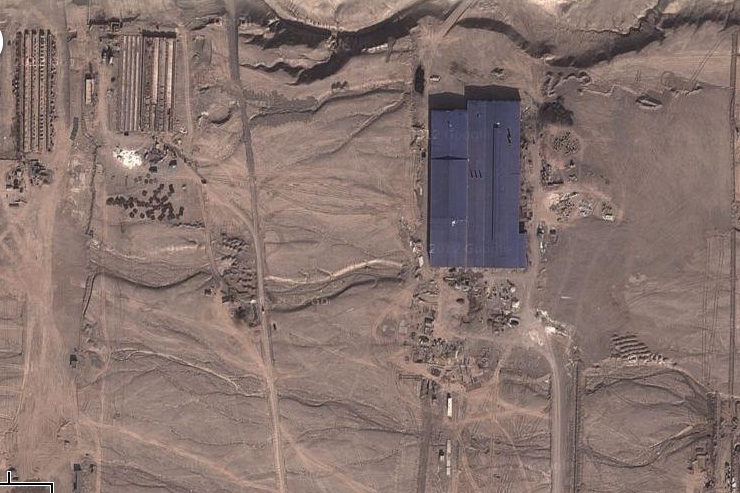
A mysterious prepare of satellite images seen on Google Earth created a stir when an ex-CIA annotator told Wired.com he had discovered "structures" in the desert effectually Kashgar, a city in China's remote Western desert that is office of the Xinjiang province.
Some speculated the buildings at the site were role of a secret military base. Simply with further analysis, Stefan Geens, a technologist and geospatial blogger who has spent months in that part of China, said the site was likely part of a major manufacturing or economic center.
Chinese-satellite-images
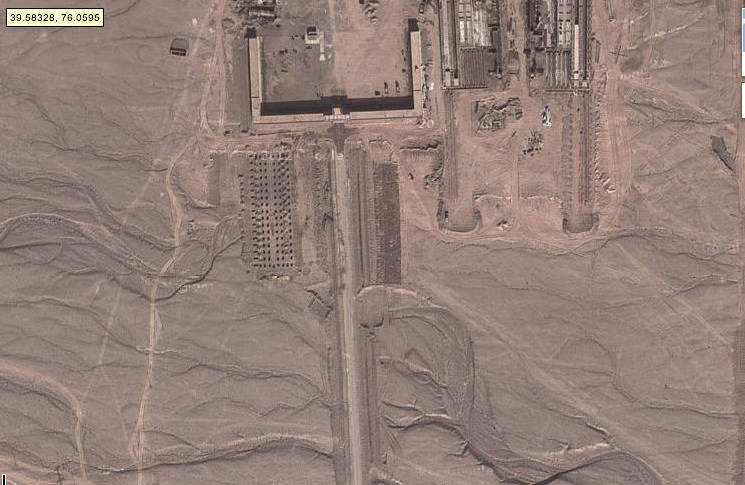
Here, another paradigm of the strange site in the Chinese desert.
I structure in the complex did somewhat resemble a helicopter testing expanse, analysts said there'southward no reason it would necessarily be linked to armed services activities. Furthermore, the site is not ideal for a clandestine armed services base, since information technology'due south relatively shut to a major population surface area and no towers or barriers were spotted, said Stuart Hamilton, former GIS program director at the Centre for Geospatial Analysis at the College of William and Mary, and now a professor at Salisbury Academy in Maryland.
Source: https://www.livescience.com/28828-10-strangest-sights-google-earth.html
0 Response to "Cork It Again Davis Google Maps"
Post a Comment